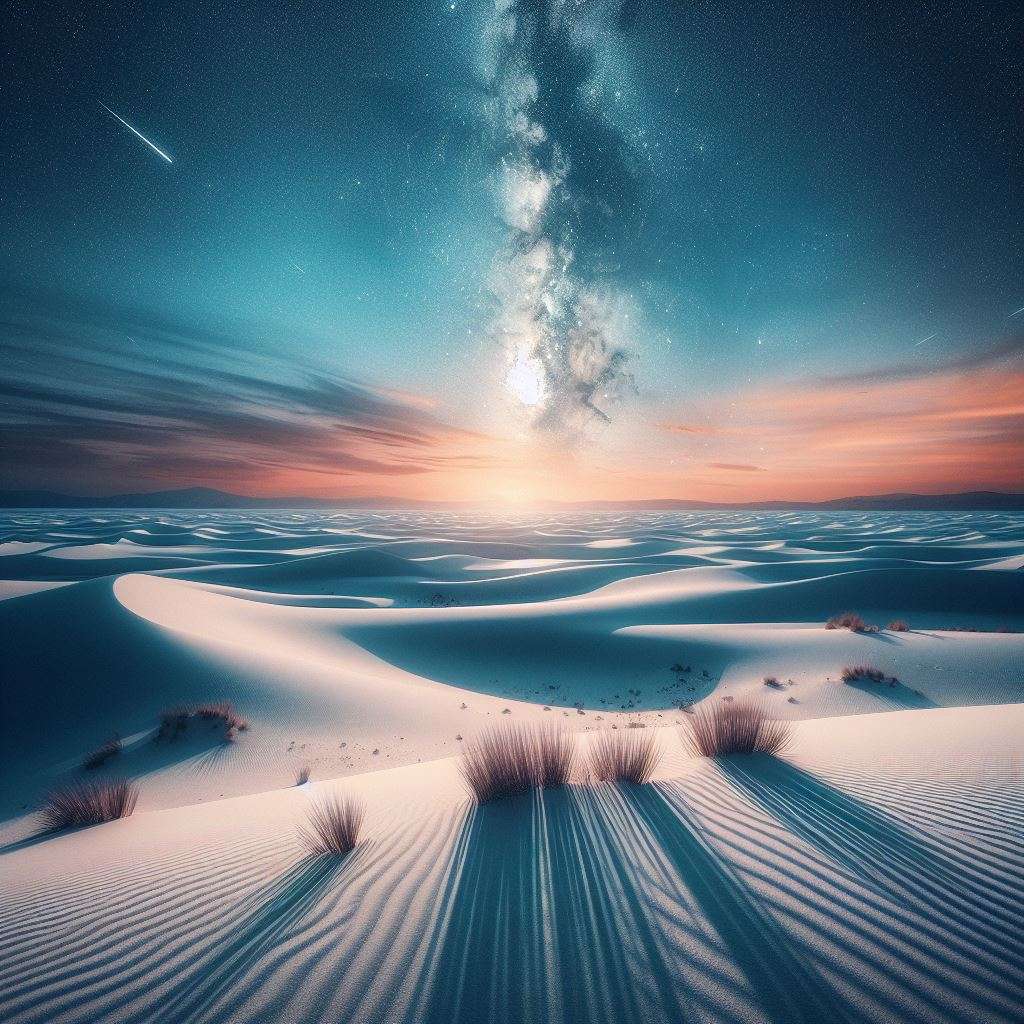White Sands National Park: 5 Mesmerising Wonders in the Heart of New Mexico’s Desert Oasis
Introduction
🌟 Welcome to the otherworldly beauty of White Sands National Park, where the desert becomes a canvas painted with pristine, rolling dunes. Picture yourself surrounded by the soft, powdery sands beneath a vast, cerulean sky – it’s a sight that defies imagination and invites exploration.
Nestled in the heart of New Mexico, White Sands is not just a destination; it’s an enchanting journey into nature’s wonders. As you embark on this adventure with us, you’ll discover the secrets hidden within the seemingly endless sea of gypsum dunes. From the sun-kissed glow at sunrise to the magical hues of sunset, White Sands promises an experience that transcends the ordinary.
Join us as we unravel the tales of this extraordinary national park, exploring its unique flora and fauna, the ethereal play of light on the sands, and the top spots that make every visit a memory to cherish. Get ready for a virtual expedition that will ignite your wanderlust and leave you yearning for the serenity of this desert oasis. So, buckle up for an unforgettable ride through the mesmerizing landscapes of White Sands National Park! 🏜️✨
Attractions in White Sands National Park:
Displayed in the table below are the leading 25 attractions within White Sands National Park, highlighting distinctive features that distinguish each site and render it remarkable.
| # | Attraction | What’s Special |
|---|---|---|
| 1 | White Gypsum Dunes | Largest gypsum dune field on Earth. |
| 2 | Interdune Boardwalk | Scenic walk through the heart of the dunes. |
| 3 | Alkali Flat Trail | Challenging trail with panoramic desert views. |
| 4 | Lake Lucero | Seasonal tour to learn about gypsum formation. |
| 5 | Playa Trail | Explore unique playa lakes in the desert. |
| 6 | Backcountry Camping | Overnight camping in the serene desert landscape. |
| 7 | Sunset Stroll | Witness breathtaking sunset over the white sands. |
| 8 | Plant and Animal Life | Discover the adapted flora and fauna of the dunes. |
| 9 | Full Moon Nights | Guided tours under the enchanting full moonlight. |
| 10 | White Sands Missile Range Museum | Explore the history of the nearby missile range. |
| 11 | Heart of the Sands Picnic Area | Picnic spot with stunning dune views. |
| 12 | Geology Museum | Learn about the unique geology of White Sands. |
| 13 | Dune Life Nature Trail | Guided nature trail showcasing desert life. |
| 14 | Playa Trail | Explore unique playa lakes in the desert. |
| 15 | Evening Program | Ranger-led programs about the park’s ecosystem. |
| 16 | First Day Hike | Start the year with a refreshing hike on January 1st. |
| 17 | White Sands Trading Company | Shop for unique gifts and souvenirs. |
| 18 | Junior Ranger Program | Engaging activities for young visitors. |
| 19 | Sunset Stroll | Witness breathtaking sunset over the white sands. |
| 20 | Star Party | Stargazing events with telescopes provided. |
| 21 | Backcountry Camping | Overnight camping in the serene desert landscape. |
| 22 | Photography Tips | Capture the beauty of the dunes with expert advice. |
| 23 | Dunes Drive | Scenic drive through the heart of the dunes. |
| 24 | Education Programs | School and group programs for an educational visit. |
| 25 | Artist-in-Residence Program | Experience art inspired by the unique landscape. |

Location and Access:
White Sands National Park is located in which state?
White Sands National Park is located in the state of New Mexico, USA. This natural wonder spans across the northern part of the Chihuahuan Desert, offering visitors a unique and mesmerizing landscape of gypsum dunes.
What is the closest airport to White Sands National Park?
The nearest airport to White Sands National Park is the El Paso International Airport, which is approximately 85 miles away. Travelers can easily access the park by road from the airport, enjoying a scenic drive through the southwestern terrain.
How do I get from Albuquerque to White Sands National Park?
To reach White Sands National Park from Albuquerque, you can take a road trip south on Interstate 25 and then east on US Highway 70. The journey offers stunning views of the New Mexico landscape, and the park is approximately a 4-hour drive from Albuquerque.
Accommodations:
Are there hotels near White Sands National Park?
Yes, there are several hotels near White Sands National Park, offering convenient accommodation options for visitors. From cozy lodges to budget-friendly motels, travelers can find suitable places to stay in nearby towns such as Alamogordo.
Can I camp at White Sands National Park?
Camping is allowed at White Sands National Park, providing a unique opportunity to experience the beauty of the dunes under the stars. The park offers both backcountry camping and group camping areas, allowing visitors to immerse themselves in the serene desert environment.
What are some RV parks near White Sands National Park?
RV enthusiasts can find suitable parks near White Sands National Park, offering facilities for a comfortable stay. Some options include Alamogordo/White Sands KOA and Sunny Acres RV Park, providing hookups and amenities for a pleasant camping experience.
Activities and Attractions:
What are the best times to visit White Sands National Park?
The best times to visit White Sands National Park are during the fall and spring when the temperatures are milder. Early mornings and evenings offer stunning lighting conditions, creating a magical atmosphere amidst the white gypsum dunes.
Are there guided tours of White Sands National Park?
Yes, the park offers ranger-led programs and guided tours, providing valuable insights into the unique ecosystems, history, and geology of White Sands. These tours enhance the visitor experience by offering in-depth knowledge about the park’s features.
What activities can I enjoy at White Sands National Park?
White Sands National Park offers a variety of activities for visitors. From exploring hiking trails and witnessing the unique flora and fauna to trying out the exhilarating experience of sledding down the gypsum dunes, there’s something for everyone.

General Information:
Are there any restrictions on bringing dogs to White Sands National Park?
While pets are allowed in certain areas of the park, they must be kept on a leash and are not permitted in the backcountry or on the park’s trails. It’s important for visitors to be aware of and adhere to the park’s pet regulations to ensure a safe and enjoyable experience for everyone.
What is the history of White Sands National Park?
White Sands National Park has a rich history dating back to ancient times when the area was covered by a vast sea. Over millions of years, the sea dried up, leaving behind the gypsum-rich sand dunes we see today. The park has witnessed the passage of time and showcases the geological wonders of the Chihuahuan Desert.
Is White Sands National Park open year-round?
Yes, White Sands National Park is open year-round, allowing visitors to experience the changing seasons and the unique beauty each one brings. It’s advisable to check the park’s official website for any temporary closures or special events that may affect accessibility.
Travel Planning:
What is the best time of day to capture photos at White Sands National Park?
The best times of day to capture stunning photos at White Sands National Park are during sunrise and sunset. The soft, warm light during these hours enhances the contrast of the gypsum dunes, creating a surreal and picturesque landscape for photographers.
How far is White Sands National Park from Phoenix?
The distance from Phoenix to White Sands National Park is approximately 380 miles. Travelers can reach the park by taking Interstate 10 East and then connecting to US Highway 70, enjoying a road trip through the scenic landscapes of the Southwest.
What are some interesting facts about White Sands National Park?
White Sands National Park is not only visually stunning but also holds intriguing facts. It is home to the world’s largest gypsum dunefield, and the park’s unique environment has been used for scientific research, including studies related to Mars exploration. The white gypsum sands also play a crucial role in the park’s distinctive flora and fauna.

10 Enchanting Facts About the World’s Largest Gypsum Dunefield:
World’s Largest Gypsum Dunefield:
White Sands National Park boasts the world’s largest gypsum dunefield, covering over 275 square miles of the Chihuahuan Desert. The dazzling white sands are composed of gypsum crystals, creating a surreal and ethereal landscape unlike any other.
Ancient Seabed Origins:
The gypsum sands of White Sands National Park originated from an ancient seabed that covered the region millions of years ago. As the sea evaporated, it left behind vast gypsum deposits, ultimately forming the stunning dunes we see today.
Unique Wildlife Adaptations:
Despite the harsh desert environment, White Sands is home to a diverse array of wildlife uniquely adapted to the gypsum-rich terrain. Look out for the elusive bleached earless lizard and the pocket mouse, both showcasing remarkable adaptations for survival.
Sledding on Gypsum Dunes:
One of the park’s most popular activities is sledding down the gypsum dunes. Visitors can rent specially designed plastic sleds at the park’s visitor center and experience the thrill of gliding down the smooth slopes of the dunes.
Moonlight Hikes and Programs:
White Sands offers moonlight hikes and programs, allowing visitors to experience the park in a completely different light. The moonlit landscape transforms the gypsum sands into a magical, silver-hued world, creating a unique nocturnal adventure.
Breathtaking Sunset Strolls:
Sunset at White Sands is a breathtaking spectacle, casting a warm glow over the expansive dunefield. The park provides an ideal setting for leisurely sunset strolls, allowing visitors to witness the shifting colors of the sands as the day comes to an end.
Rich Cultural History:
The Tularosa Basin, where White Sands is located, has a rich cultural history. Evidence of human presence in the area dates back over 10,000 years, with indigenous peoples leaving their mark on the land through artifacts and petroglyphs.
Military Use during World War II:
The unique terrain of White Sands made it an ideal location for military testing during World War II. The Trinity Site, where the first atomic bomb was detonated, is located within the park’s boundaries, highlighting its historical significance.
Fluctuating Dune Shapes:
The gypsum dunes at White Sands are in a constant state of flux. Wind and weather conditions cause the dunes to shift and change shape, creating a dynamic landscape that is never the same from one visit to the next.
Stargazing in the Desert Sky:
White Sands National Park is a designated International Dark Sky Park, making it a haven for stargazers. The absence of light pollution allows visitors to witness a spectacular display of stars and celestial bodies, making it an ideal destination for astronomy enthusiasts.

10 Must-Know Facts Before Exploring White Sands National Park:
Unique Gypsum Composition:
Before embarking on your journey to White Sands National Park, it’s crucial to understand the geological marvel that defines its landscape. The park’s stunning white sands are not your typical silica-based grains; instead, they are composed of gypsum crystals. This distinct composition results in a mesmerizing, almost surreal terrain that sets White Sands apart as the world’s largest gypsum dunefield.
Extreme Temperatures:
White Sands National Park experiences extreme temperatures, particularly during the scorching summer months. The gypsum sands can become exceptionally hot under the intense desert sun. To ensure a comfortable visit, plan your exploration during the cooler parts of the day, bring ample water to stay hydrated, and consider wearing appropriate sun protection, including sunscreen, sunglasses, and a wide-brimmed hat.
Sun Protection is a Must:
Given the reflective nature of the gypsum sands, effective sun protection is a must for visitors. The bright landscape intensifies sunlight exposure, making it crucial to pack and apply sunscreen regularly. Don’t forget to bring sunglasses to shield your eyes from the glare, and a wide-brimmed hat to provide additional shade and protection.
Sledding Excitement:
Elevate your White Sands experience by indulging in the unique activity of sledding down the gypsum dunes. At the park’s visitor center, you can rent specially designed sleds for an exhilarating adventure on the smooth slopes. This family-friendly activity adds an extra layer of fun to your visit, allowing you to embrace the playful side of the gypsum dunefield.
Moonlight Magic:
To witness White Sands in a different light—literally—consider planning your visit around the park’s moonlight programs. Moonlight hikes and events provide a magical perspective as the gypsum sands shimmer under the glow of the moon. It’s a rare opportunity to experience the dunes in a serene and otherworldly atmosphere.
Watch the Sunset:
Sunset at White Sands is a breathtaking spectacle that should not be missed. As the sun dips below the horizon, the gypsum sands transform into a canvas of warm hues. Plan your visit to coincide with sunset, and take a leisurely stroll to absorb the ethereal beauty of the shifting colors across the expansive dunefield.
Wildlife Encounters:
White Sands is not just a stunning landscape; it’s also home to unique desert wildlife. Keep your eyes peeled for the bleached earless lizard and the pocket mouse, both adapted to thrive in the challenging desert environment. Observing these creatures in their natural habitat adds a fascinating dimension to your visit.
Cultural Significance:
Delve into the cultural history of the Tularosa Basin, where White Sands is situated. With evidence of human presence dating back over 10,000 years, the area carries a rich legacy of indigenous peoples. Take the time to explore the cultural contributions that have shaped the landscape, leaving behind artifacts and petroglyphs that tell stories of the past.
Military History:
White Sands National Park played a pivotal role in military testing during World War II. The Trinity Site, located within the park’s boundaries, marks the historic site where the first atomic bomb was detonated. Learn about this significant chapter in history, adding a layer of historical context to your visit.
International Dark Sky Park:
For astronomy enthusiasts, White Sands is a designated International Dark Sky Park. This prestigious designation ensures minimal light pollution, providing optimal conditions for stargazing. Take advantage of the clear desert skies to witness a spectacular display of stars and celestial wonders during your visit, creating a celestial finale to your exploration of this extraordinary national park.

Top 10 Unique FAQs for an Unforgettable White Sands National Park Adventure:
Why is the sand at White Sands National Park so white?
The brilliant white color of the sand is attributed to its composition of gypsum crystals. Unlike typical sandy deserts, the gypsum here reflects the sunlight, creating a dazzling and unique landscape.
Can I bring my own sled for sledding on the dunes?
While the park encourages visitors to rent specially designed sleds at the visitor center for an optimal experience, bringing your own sled is allowed. However, it’s crucial to ensure that the sled is appropriate for the sand conditions to avoid potential safety concerns.
What wildlife can I expect to encounter at White Sands?
The park is home to a variety of wildlife, including the bleached earless lizard and pocket mouse. Visitors may also spot insects, reptiles, and birds adapted to the challenging desert environment, enhancing the overall natural experience.
Are there any guided tours available, and how do I join one?
White Sands National Park offers ranger-led programs and guided tours. Check the park’s official schedule or inquire at the visitor center for details on available tours, providing valuable insights into the park’s geology, flora, fauna, and cultural history.
How does the park preserve its dark skies, and what stargazing opportunities are available?
As an International Dark Sky Park, White Sands employs measures to minimize light pollution, creating an ideal environment for stargazing. The park occasionally hosts astronomy events, allowing visitors to explore the celestial wonders with the guidance of experts.
What is the significance of the Trinity Site within the park?
The Trinity Site marks the historic location where the first atomic bomb was detonated during World War II. Visitors can learn about this pivotal moment in history, showcasing the park’s dual role as a natural wonder and a site of historical importance.
Can I explore the park at night, and what safety precautions should I take?
Nighttime exploration is allowed, especially during moonlit programs. However, visitors should be well-prepared with flashlights, appropriate clothing, and knowledge of the park’s terrain. Check with park rangers for any specific guidelines or restrictions.
How can I learn more about the cultural history of the Tularosa Basin?
Delve into the rich cultural history of the Tularosa Basin by exploring artifacts and petroglyphs left by indigenous peoples. The park may offer interpretive programs or exhibits providing insights into the cultural contributions that shaped the region.
What is the best time to visit White Sands to avoid extreme temperatures?
To avoid the scorching summer heat, the best times to visit are during the fall and spring. Early mornings and evenings offer milder temperatures, creating a more comfortable environment for exploration.
Are there any special events or festivals held at White Sands throughout the year?
White Sands National Park occasionally hosts special events, festivals, and programs. Check the park’s official website or inquire at the visitor center for information on upcoming events, enhancing your visit with unique experiences and activities.
You may also consider discovering information about Grand Teton National Park.

